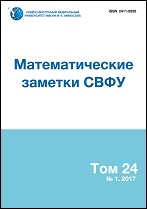|
This article is cited in 1 scientific paper (total in 1 paper)
Mathematical modeling
Stochastization of classical models with dynamical invariants
E. V. Karachanskaya
Far-Earstern State Transport University, 47 Serysheva Street, Khabarovsk 680027, Russia
Abstract:
The article considers the possibility of construction of stochastic analogues for classical models described by a differential equations system and having an invariant function. The suggested method of stochastization is based on both the concept of the first integral for a stochastic differential Ito equations system (SDE) and the theorem for construction of the SDE system using its first integral. We consider three models. The first is a simple mathematical model of epidemics or the SIR (susceptible-infectedrecovered) model, the second is the predator-prey model, and the third model is the multistage multi-enzymatic chemical reaction. The process of stochastization includes three constituents of the classical model. The first constituent is the diffuse component and described by the Wiener process violence, the second describes the intermittent transition connected with the Poisson jumps realization, and the third is the complementary function for the drift coefficient. We construct systems of stochastic differential Ito equations with Poisson jumps for the SIR model and the predator-prey model. The stochastic analogue for the third model is described with the use of a stochastic differential Ito equations system without Poisson jumps. We use a collection of functions, including an invariant function, several complementary functions, and arbitrary functions to construct coefficients for the differential equations system. It is shown that the choice of complementary functions allows us to obtain such coefficients that ensure that the solution of the differential equations system satisfies some reasonable limitations. Examples of differential equations system construction are obtained using the author's MathCad computer software for analytical simulation. The obtained numerical solutions of the systems verify the theoretical propositions and preserve the constant value for the dynamic invariant function for any realizations of the SDE solutions.
Keywords:
stochastic model, invariant of dynamical model, construction of Itô equations.
Received: 20.10.2019
Revised: 22.01.2020
Accepted: 17.02.2020
Citation:
E. V. Karachanskaya, “Stochastization of classical models with dynamical invariants”, Mathematical notes of NEFU, 27:1 (2020), 69–87
Linking options:
https://www.mathnet.ru/eng/svfu279 https://www.mathnet.ru/eng/svfu/v27/i1/p69
|

| Statistics & downloads: |
| Abstract page: | 85 | | Full-text PDF : | 51 |
|




 Contact us:
Contact us: Terms of Use
Terms of Use
 Registration to the website
Registration to the website Logotypes
Logotypes








 Citation in format
Citation in format 
